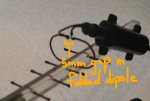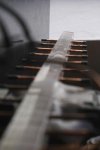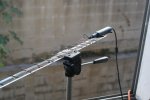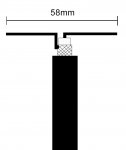I am trying to access a local public Internet access point at 2.4 gHz using a homemade Yagi-Uda antenna. I built the first such antenna using 2mm copper rod and wooden boom with 8 directors, and in the end it worked, but my signal strength was only about -67 to -79 dBd so I decided to try building a larger/ longer antenna with 12 directors and a more durable and weather-resistant acrylic boom hoping to get a signal that was consistently at least around -65 decibels. I am using a program called NetSpot vers. 2.8.1.600 to get signal readings, and I used a program called Yagi Calculator version 2.6.18 to compute the positions and lengths of my various elements and their distances apart for both antennas (see attached PDF for the results of the Yagi Calculator). With the second antenna finished, I was very optimistic about its performance.
Well, it works, but the second antenna is decidedly much less effective at reaching its access point. Instead of an expected improvement in gain, I have had a significant reduction (signal is now down to -75 to -96 decibels) and I frequently cannot reach the Internet through it at all. I had carefully measured the length of each director using a steel calipers with accuracy down to hundredths of a millimeter for both antennas, and the elements are accurate to within 0.1mm of the length that the Yagi Calculator had told me they should be. I used this same calipers to measure the distance between each element on both antennas, so I am pretty confident their positions are also quite accurate. I used a drill press to cut the holes in the acrylic bar to ensure that they would be very straight and very consistent. I have had an eyeball look at the final alignment of the elements, and they look like they are lining up nicely and are tapering the way they should be all along both sides of the length of my boom. My folded dipole is a little less graceful on the second antenna than on the first, but is the correct width according to the Calculator and is still quite close to the correct shape and size (one thing I have never understood: should the hole in the boom for the driven element be placed along the same line as the holes for the directors and reflector? This is where I have placed mine in both antennas).
I am using the same 802.11 USB wireless LAN card for this second antenna as I did for the first. The card was originally a "19-gain" omnidirectional antenna that I modified and converted into a directional Yagi-Uda. My computer has no difficulty detecting the card when I plug the USB cable into it.
The boom on the second antenna is connected to a camera tripod which holds the antenna about four feet out my apartment window (which looks somewhat precarious, see photo). The previous boom was attached to a hollow metal tube out this same window. I can't think of anything about the boom support structure that should be affecting my antenna's reception, but then I am very much a novice here.
I am including photographs of this second build, now that it is complete. Does anyone have any ideas about why I might be experiencing such a reduced level of signal quality? I realize that the 12-director antenna has a narrower angle of reception, and that I must aim it more accurately at its target in order to get a decent signal, but I am pretty sure I am aiming it as well as I had done before (my target is about 400 feet away). On the second antenna, the card is located somewhat closer to the dipole and is over the reflector, since there was no more length on my boom to attach it-- I don't know if the location of the card should be having any affect here or not).
Also: while I was able to use a continuous piece of wood for the first antenna, for the second one I had to use two pieces of acrylic. They are attached to each other with two short (1/2" long) stainless steel pegs (would these be affecting reception? They do not contact any of the directors). Each element of the second antenna is held in place with a few drops of UV reactive adhesive (the wooden boom's elements did not require any adhesive) and I have capped each element with a short length of heat-shrink tubing so that their ends would be protected (turns out that 2mm copper rod when cut precisely with a dremel tool at a right angle produces some sharp edges).
I am assuming there must be something structural about my second antenna which is causing its reception to be so much weaker, but cannot figure what it must be (e.g., am wondering if somehow the acrylic boom is affecting the signal, though I thought this would be invisible to the incoming radio waves). Am hoping that by describing the build and showing others some photographs of it, someone will be able to look at it and say, "Here's your problem right here..." and explain what I need to fix. Any takers?? After so much precision of execution on my end, it is especially disappointing to be greeted with a penalty rather than an improvement. I am a man out of ideas.
Well, it works, but the second antenna is decidedly much less effective at reaching its access point. Instead of an expected improvement in gain, I have had a significant reduction (signal is now down to -75 to -96 decibels) and I frequently cannot reach the Internet through it at all. I had carefully measured the length of each director using a steel calipers with accuracy down to hundredths of a millimeter for both antennas, and the elements are accurate to within 0.1mm of the length that the Yagi Calculator had told me they should be. I used this same calipers to measure the distance between each element on both antennas, so I am pretty confident their positions are also quite accurate. I used a drill press to cut the holes in the acrylic bar to ensure that they would be very straight and very consistent. I have had an eyeball look at the final alignment of the elements, and they look like they are lining up nicely and are tapering the way they should be all along both sides of the length of my boom. My folded dipole is a little less graceful on the second antenna than on the first, but is the correct width according to the Calculator and is still quite close to the correct shape and size (one thing I have never understood: should the hole in the boom for the driven element be placed along the same line as the holes for the directors and reflector? This is where I have placed mine in both antennas).
I am using the same 802.11 USB wireless LAN card for this second antenna as I did for the first. The card was originally a "19-gain" omnidirectional antenna that I modified and converted into a directional Yagi-Uda. My computer has no difficulty detecting the card when I plug the USB cable into it.
The boom on the second antenna is connected to a camera tripod which holds the antenna about four feet out my apartment window (which looks somewhat precarious, see photo). The previous boom was attached to a hollow metal tube out this same window. I can't think of anything about the boom support structure that should be affecting my antenna's reception, but then I am very much a novice here.
I am including photographs of this second build, now that it is complete. Does anyone have any ideas about why I might be experiencing such a reduced level of signal quality? I realize that the 12-director antenna has a narrower angle of reception, and that I must aim it more accurately at its target in order to get a decent signal, but I am pretty sure I am aiming it as well as I had done before (my target is about 400 feet away). On the second antenna, the card is located somewhat closer to the dipole and is over the reflector, since there was no more length on my boom to attach it-- I don't know if the location of the card should be having any affect here or not).
Also: while I was able to use a continuous piece of wood for the first antenna, for the second one I had to use two pieces of acrylic. They are attached to each other with two short (1/2" long) stainless steel pegs (would these be affecting reception? They do not contact any of the directors). Each element of the second antenna is held in place with a few drops of UV reactive adhesive (the wooden boom's elements did not require any adhesive) and I have capped each element with a short length of heat-shrink tubing so that their ends would be protected (turns out that 2mm copper rod when cut precisely with a dremel tool at a right angle produces some sharp edges).
I am assuming there must be something structural about my second antenna which is causing its reception to be so much weaker, but cannot figure what it must be (e.g., am wondering if somehow the acrylic boom is affecting the signal, though I thought this would be invisible to the incoming radio waves). Am hoping that by describing the build and showing others some photographs of it, someone will be able to look at it and say, "Here's your problem right here..." and explain what I need to fix. Any takers?? After so much precision of execution on my end, it is especially disappointing to be greeted with a penalty rather than an improvement. I am a man out of ideas.









